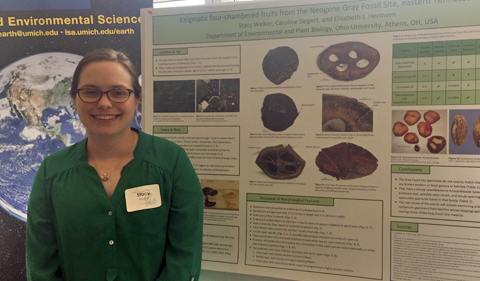
Stacy Welker presents her poster at the University of Michigan.
Undergraduate student Stacy Welker presented a poster on “Enigmatic four-chambered fruits from the Neogene Gray Fossil Site, eastern Tennessee” at the 34th Midcontinent Paleobotanical Colloquium at the University of Michigan May 12-14.
The poster was co-authored by another undergraduate student, Caroline Siegert of Honors Tutorial College, as well as Dr. Elizabeth Hermsen, Assistant Professor of Environmental & Plant Biology.
Welker received funding to attend the colloquium through the Environmental & Plant Biology Department’s Faculty and Staff Memorial Fund. Her award honored Dr. Laurence A. Larson, formerly a faculty member in the department.
Abstract: The Gray Fossil Site in northeastern Tennessee provides a rare look at species occurring in a warm oak-hickory forest environment in the late Miocene to early Pliocene of the eastern United States. In addition to vertebrates, a wealth of fruit and seed fossils have been recovered from the Gray Fossil Site sediments, including specimens that appear to represent either the endocarps of drupaceous fruits or possibly woody capsules. The fossils measure approximately 11 to 13 mm in length and 9 to 14 mm in width. Their outer surfaces are smooth with no ornamentation, pitting, or obvious features for dehiscence or germination. In lateral view, the endocarps/capsules are widely elliptic to orbicular in shape; one end is truncate while the other has a pointed projection. The endocarps/capsules have four locules exposed at the truncate end. In cross section, the endocarps/capsules are elliptical. A sectioned specimen exhibiting little to no compression reveals that the chambers are divided by thick septa with two parallel, off-center, pinpoint channels. The channels can be observed externally on either side of the basal projection. Extant and fossil genera having drupes with four-locular endocarps or apically dehiscent four-locular capsules sharing features with the four-chambered Gray Fossil Site fruits include, e.g., members of Cornaceae (e.g., Alangium, Cornus), “Hartziella” (Onagraceae?), Ludwigia (Onagraceae), Symplocos (Symplocaceae), and Pallioporia (Symplocaceae?). However, the Gray Fossil Site material differs in critical features from all taxa thus far investigated, and the fossils may represent a previously unknown genus.



















Comments